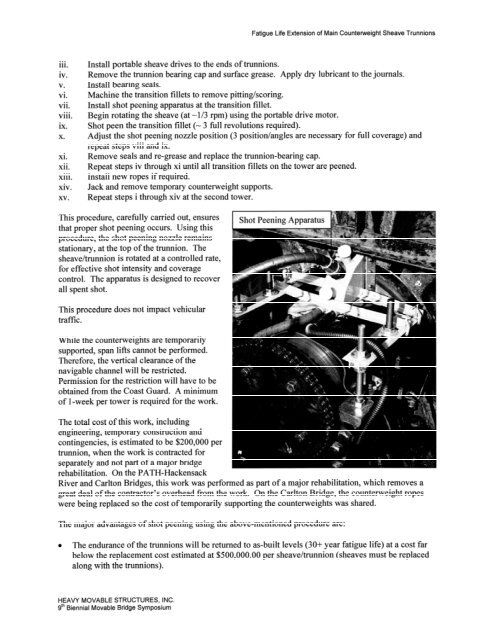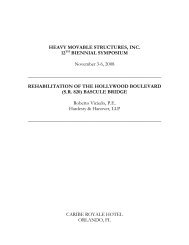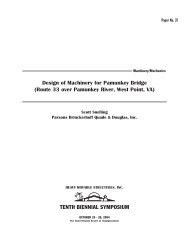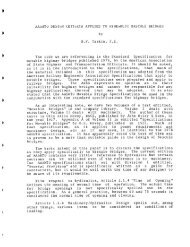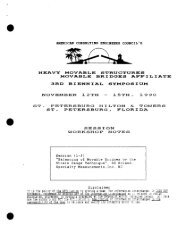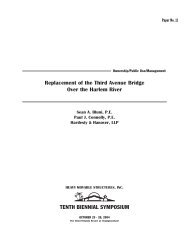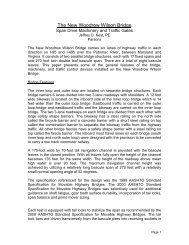Fatigue of Counterweight Sheave Trunnions - Heavy Movable ...
Fatigue of Counterweight Sheave Trunnions - Heavy Movable ...
Fatigue of Counterweight Sheave Trunnions - Heavy Movable ...
Create successful ePaper yourself
Turn your PDF publications into a flip-book with our unique Google optimized e-Paper software.
. . .<br />
111.<br />
iv.<br />
v.<br />
vi.<br />
vii.<br />
viii.<br />
ix.<br />
X.<br />
xi.<br />
xii.<br />
...<br />
X111.<br />
xiv.<br />
xv .<br />
<strong>Fatigue</strong> Life Extension <strong>of</strong> Main Counteweight <strong>Sheave</strong> <strong>Trunnions</strong><br />
Install portable sheave drives to the ends <strong>of</strong> trunnions.<br />
Remove the trunnion bearing cap and surface grease. Apply dry lubricant to the journals.<br />
Install bearing seals.<br />
Machine the transition fillets to remove pittinglscoring.<br />
Install shot peening apparatus at the transition fillet.<br />
Begin rotating the sheave (at -113 rpm) using the portable drive motor.<br />
Shot peen the transition fillet (- 3 hll revolutions required).<br />
Adjust the shot peening nozzle position (3 position/angles are necessary for full coverage) and<br />
repeat steps viii and ix.<br />
Remove seals and re-grease and replace the trunnion-bearing cap.<br />
Repeat steps iv through xi until all transition fillets on the tower are peened.<br />
Install new ropes if required.<br />
Jack and remove temporary counterweight supports.<br />
Repeat steps i through xiv at the second tower.<br />
This procedure, carefully carried out, ensures<br />
that proper shot peening occurs. Using this<br />
procedure, the shot peening nozzle remains<br />
stationary, at the top <strong>of</strong> the trunnion. The<br />
sheaveltrunnion is rotated at a controlled rate,<br />
for effective shot intensity and coverage<br />
control. The apparatus is designed to recover<br />
all spent shot.<br />
This procedure does not impact vehicular<br />
traffic.<br />
While the counterweights are temporarily<br />
supported, span lifts cannot be performed.<br />
Therefore, the vertical clearance <strong>of</strong> the<br />
navigable channel will be restricted.<br />
Permission for the restriction will have to be<br />
obtained from the Coast Guard. A minimum<br />
<strong>of</strong> 1 -week per tower is required for the work.<br />
The total cost <strong>of</strong> this work, including<br />
engineering, temporary construction and<br />
contingencies, is estimated to be $200,000 per<br />
trunnion, when the work is contracted for<br />
separately and not part <strong>of</strong> a major bridge<br />
rehabilitation. On the PATH-Hackensack<br />
River and Carlton Bridges, this work was perf<br />
great deal <strong>of</strong> the contractor's overhead from th<br />
were being replaced so the cost <strong>of</strong> temporarily<br />
lned as part <strong>of</strong> a major rehabilitation, which removes a<br />
work. On the Carlton Bridge, the counterweight ropes<br />
upporting the counterweights was shared.<br />
The major advantages <strong>of</strong> shot peening using the above-mentioned procedure are:<br />
The endurance <strong>of</strong> the trunnions will be returned to as-built levels (30+ year fatigue life) at a cost far<br />
below the replacement cost estimated at $500,000.00 per sheaveltrunnion (sheaves must be replaced<br />
along with the trunnions).<br />
HEAVY MOVABLE STRUCTURES, INC.<br />
9Ih Biennial <strong>Movable</strong> Bridge Symposium


